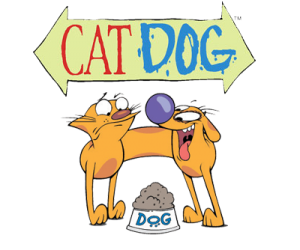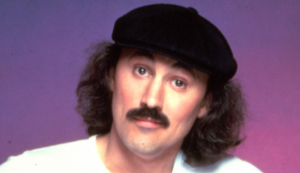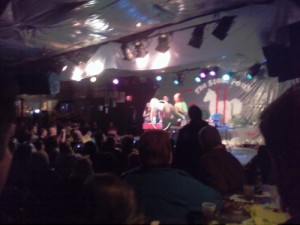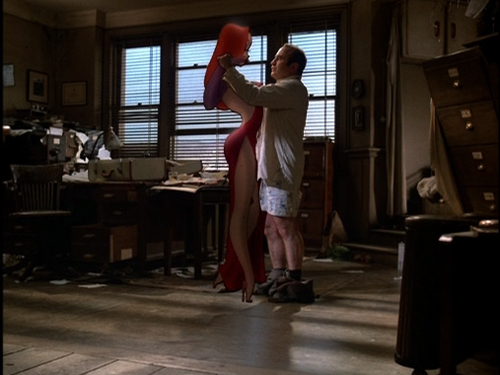Posts Tagged Comedy
CLOSE REVEIW: CATDOG
Posted by kjohnson1585 in Television, Uncategorized, Writing on February 3, 2010
I apologize for the lack of updates, as I had to quickly get reacquainted with the East Coast time. I am working on two other columns, one for Damnlag, a brand new gaming website, and one for Wildsound, a film review website. [The latter is really hard to navigate, and there’s no general link to the specific articles I wrote. I did the ones for Freaks, Dracula, The Incredible Shrinking Man, The Fly, and other films that’s earlier than 1950.] I am also working on a comic AND putting together a pitch for a cartoon sitcom. Details about those two will come later.
CHILDHOOD REVISITED features will not be weekly, but more or less done on a “when I can” basis. This allows me to do other writeups without having to spend time watching a movie, something I have less and less time to do, until the summer at least. So, I will be providing more analysis of various cartoons, shows, and other entertainment elements that ought to be explored. Should be goooooooood.
First up – A Review of “take it or leave it” CatDog!
———————————
CATDOG
It could be argued to a certain extent that Nickelodeon’s CatDog triggered the onslaught of the more absurdist, surreal types of animation that now assaults the airwaves of Disney, Cartoon Network, and Nick itself. The departure from clearly defined character models and coherent settings allows far a larger pool of insane scenarios to pull from. This kind of variety doesn’t really exist beyond the classic shorts of the 50s, whose 4 minute escapades could occur anywhere.
CatDog was somewhat remarkably genius in its simple, odd premise. Prior to this cartoon, dogs and cats were pointedly DIFFERENT and constantly ENEMIES. Always. Cartoons cribbed from the canine’s propensity to chase felines as a universal sign of their natural animosity. Writers and animators chose sides and inevitably valued one over the other. Dog City. Road Rovers. Garfield. Heathcliff. Notice, too, the pack-group collectiveness of the dog-shows in comparison to the single-lead entity of the cat-shows. Dog lovers are SOCIAL! Cat lovers are INDEPENDENT! This is what IT MUST BE.
So for producers of CatDog to say “Well, let them be roommates” is relatively fresh in itself, but to either up the strangeness or justify the pairing, they had to be not only brothers, but… joined, exactly at the waist.
What we have here is an organic creature where one side is a dog and one side is a cat. The cat’s name is Cat. The dog’s name is Dog. Cat. Dog. CatDog.
Being joined at the waist must have been a NIGHTMARE for the animators. Luckily, following the laws of physics wasn’t necessary, but maintaining the lively movement between the co-joined siblings still seemed particularly nasty, even given the ability to stretch the torso as much as necessary. Their body was essentially a Slinky, their legs and arms interchangeable. But there were the shoes and the skates and the coats and the occasional pants, and the driving and the eating at a table and the fighting and the running and so on. How do you portray all that without looking, well, stupid? The answer? You can’t. But still, you gotta give them credit for trying.
The simplistic brilliance of actually pairing a dog and a cat is undermined by the on-the-nose names, but at least that would have been meta-comedic. Their personalities, however, became the primary issue, cribbed from both the consistent clichés of conflicting brothers AND the pre-conceived personification of canine and feline attitudes. Dog is playful, goofy, loves to fool around; Cat is serious, cultured, well-groomed. There was no subtlety to those personalities, which was perhaps the show’s main downfall (there was others, which will be addressed.)
I’m reminded of the Angry Beavers, which, prior before hitting its excellent stride of brilliant soul-music parodies, its speedy insanity, its comically, well-done side characters, and its uniquely defined characteristics, began as the inane pairing of one stupid brother fucking up while the other, smarter one exploited him and reaped the rewards. I suppose this personality clash can create a number of stories, but the formula is stale from the get-go: pick a setting, pick a conflict: dumb brother loses, smart brother wins.
AB improved leaps and bounds when it showed the willingness to not only put Dagget in the spotlight, but to put both of them in insane situations and watch them respond. Norbert’s superiority became arrogance and jealousy, which made him his own brand of stupid. Once Dagget and Norbert began getting smashed by trees an equal number of times, once the formula was destroyed, the show became a classic.
Unfortunately, CatDog consistently maintained the Cat-smart, Dog-dumb balance no matter what happened, which made the craziest, most unique and eccentric of plotlines come off stale. Dog would want, or do, something, Cat would grumble and sprout a sense of superiority, Dog would be sad. Then – BLAM – something happens that would make Dog appear right and Cat look dumb, Cat would apologize and they’d hug as family. This happened pretty much like clockwork, which was disappointing; CatDog reeked of tremendous potential.
Children aren’t stupid. They probably don’t think in terms of social interaction, but they understand the concept that, yeah, being two natural enemies joined at the waist must be fucking hard. You hate each other, and society hates your freakish nature. Somehow, you have to cope. CatDog could have been cleverer in that regard, but opted for the simpler stories and generic cartoon fare, which made the more surrealist elements of the settings seem more gimmicky than purposeful.
When they did make episodes that played to Cat and Dog’s strengths — when they did indeed have their transformative moments — they were more than often pretty good to excellent, but they came so far in between that it wasn’t worth the mundane tediousness of the regular show’s staple. Those strong episodes, more often than not, came against the show’s most frustrating set of character this side of the cast of Heroes.
The Greasers.
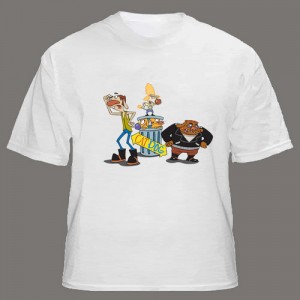
If you wore this shirt everyday forever, you'd still encounter The Greaser less than the 4 seasons of CatDog.
This trio of dogs and their mere existence to destroy CatDog went from nominally intriguing to downright, insultingly maddening. The Greasers, comprised of the gruff n’ buff leader, the high-squealing, short, female sidekick (who, of course, has a secret love interest for Dog), and their bumbling, moronic third member, spent every scene chasing CatDog for the sole intent of beating this piss out of them. The Greasers meant to represent the meanest of society’s constituents, whose obsession for purity invokes an unexplainable hatred for this mixed abomination. But as the episodes went by, and more of the Greaser’s exploits became more obvious, they were no longer that meaningful.
For one thing, it became clear that the Greaser’s hated Cat over Dog. While that’s understandable to a certain extent, it is essentially asinine without some sort of contrast. Where was the pro-Cat gang? Elevating the Greaser’s hatred towards CatDog to a direct, anti-Cat position skewed the entire show’s central premise. Why break down the cat vs. dog wall only to render it moot with a pro-Dog, anti-Cat antagonist? It would have been richer to keep The Greasers’ displeasure at the overall mix instead of the feline half.
At some point, though, the creators must have became aware of this, as the Greasers in time stopped being a gang of CatDog (emphasis on CAT) haters and instead became the show’s staple conflict catalyst. They became what the Red Man was on Cow And Chicken – CatDog’s consistent obstacle into whatever they needed to do. Climbing a mountain? The Greasers want to stop you! Going on a flight? Guess who’s running security! And so on.
This gave way to the other central problem to the show: TOO. MUCH. GREASERS. Between the second and third season, maybe two episodes had nothing to do with them. They were fucking everywhere, endlessly popping up and meddling in CatDog’s affairs, their lives going from a punk gang that messed with CatDog for kicks into a group whose SOLE existence depended on assaulting CatDog for their mere survival. If they didn’t at least throw one punch at CatDog, God would SMOTE them. This was made worse by the mere fact that CatDog already had their own Red Man – a green bunny character who played the role of anything that didn’t necessarily hate CatDog, but could cause problems all the same, just by being a jackass. With this character already causing enough issues, was the overabundance (over-dependence being more apt) of the Greasers really necessary?
Even as the show harped on its ultra-one-note direction, it perhaps had a bright moment with their TV-movie, which involved a ridiculous search for their parents. The twist being their parents were NOT a cat or dog couple, but two other species entirely, implying they were adopted. This certainly brought up a number of questions: where are the real parents? Were they abandoned? But such rich questions were never meant to be; the writers had no interest in pursuing this. Besides, the show was canceled after four seasons.
CatDog was a show that lacked the wherewithal and self-awareness to make something clever and interesting; instead being content to run through the gamut of generic siblings and overdone-to-the-point-of burnt Greaser plots. Its minor triumphs couldn’t overcome its overall blandness, and even with its surreal elements, it never brought them to any poignant use. Despite the potential for weird greatness, CatDog was as uninteresting as its name…. and its theme song.
A Relic from the Past?
Posted by kjohnson1585 in Television, Uncategorized, Writing on January 10, 2010
I spent my evening watching Gallagher last night.
I would never waste an iota of my time watching some aged prop comedian do nothing but smash watermelons and “pies” for an hour – at least, under normal circumstances. But then, I read this fantastically insane interview from the AVClub, an incredibly eye-opening revelation on the mind of this played-out comedian: by which I mean I never would have thought that the one-note version of Carrot Top would have such strong, angry and utterly senile point of view. (While the inability to understand why comedians bring water on stage is pretty astounding, his complete incomprehension of the advantages of home-team games is my favorite part.) Please read it; you won’t regret it.
Gallagher, I suddenly realized, is essentially Peter Finch from Network without a producer crazy enough to give him a show. And a hammer. Suddenly, my mind started reeling: you mean to tell me that his “comedy” “routine” contains MORE than smashing shit with a hammer? I had to go and figure out what else goes on during one of his shows, something he would describe as “performance” “art”.
The Stone Pony in Asbury Park is a fairly crappy venue, a club of all-black walls and local rock bands that hosts mostly that older crowd that still thinks they’re Forever Young. As I entered and paid for my ticket, I asked the lady manning the both how the sales were that night. “Pretty good,” she said. “We have about three hundred people.” Huh. Scanning the crowd, I certainly didn’t see about “three hundred” people. Maybe one hundred and fifty. Maybe the staff bought more tickets to make Gallagher feel good? I have no idea.
For someone harping on his professionalism, he started thirty minutes late. He came on stage and, god help me, I had no idea what was happening. He began by throwing Hershey Kisses at the crowd, and somehow tied it to finding cocaine. He mentioned how he wouldn’t want to be president because “they examine your life too closely”. He’d like to be a king or ruler, though; but wants everyone to think for themselves, since anything else would be communism.
Gallagher has absolutely no concept of irony; or, at the very least, no idea how hypocritically asinine he sounds. He has does have a routine, which begins comparing kids that wear sagging pants to prisoners (he actually compares a lot of people to prisoners). He has issues with, uh, telephone poles on roads, and words that end in vowels. Words have too many meanings! Mexicans haven’t changed their language over time! (I assume he means Spanish, and yes, yes it has changed over time).
His jokes are terrible, mainly because they’re wrong. I don’t mean offensive, but incorrect. The audience cheered with mediocre enthusiasm – that overweight, pro-family-values “teabagger” crowd (no black people, save for the two woman that worked there) . No one laughed, per se, but mostly agreed with him. Someone next to me was on the phone and mentioned how “funny” Gallagher was, but he never actually laughed at him. Comedy, these days, is about agreeing with your audience. Gallagher actually admits this.
He then starts to ramble, literally just a number of nonsensical “observations,” which actually did make me laugh. He sounded like Grandpa on The Simpsons; one gold rant had him complaining about Northface backpacks, and why they didn’t call it Southface, because they wouldn’t climb in the South. Or something. It was bizarre.
Two particular moments stand out. One: he called a few ladies on stage and had them wear boxers with holes cut out the crotch for shirts. One of them, a “dancer” named Sugar, was forced to hula hoop on a table.
This led to some dude who looked like Super Mario with a cigar to hit on her for some after-club activities. She was quite drunk, and he and the gal starting talking really loud, which got the audience pissed. I was disappointed that a fight didn’t break out.
The second, more disturbing part was when a father forced his seven year-old kid onto the stage for a Gallagher bit, which consisted of eating Pepto-Bismol-covered dog food and spam. Gallagher proceeds to berate the kid, who clearly is nervous and utterly embarrassed. It was probably the most awkward thing I’ve ever seen, made even more awkward when Gallagher called his father on stage. Come to find out, he was actually his STEPfather (Gallagher to kid: “you’re gonna get divorced when you grow up!”), and when he refused to take his son’s place to eat the shit, made the kid do it. He at least got to spit it up, but then Gallagher threw soda in his face. The stepfather just laughed.
I’m pretty sure that’s enough evidence to call DYFS.
By this time, two bloody hours went by, and the audience mistook their exasperation and annoyance for general fatigue (Gallagher kept comparing his will to Springsteen). And so came the pies and the cakes and the watermelon, and he smashed them one after the other, to the delight of the crowd, and it was at this point I realized something.
His smashing act is the penultimate act of a terrible, horrendous routine of nonsense. A character clearly in need of medication and bed rest is left to scream and yell (and cough and almost pass out on stage) until the crowd gets annoyed of the shit. Then he smashes food, both to wake up the crowd AND let loose the last bastions of his unrepentant anger; I swear it looked like he was about to cry as he kept swinging his hammer, and for a moment, I kinda felt bad for this guy, a figure that clearly is stuck in his non-existent America, happy to cater to his ignorant fan-base, mistaking comedic adaptation with stupid conformity. I wanted to ask about his issues with water, but I no longer had the heart. Like so many bigoted Archie Bunkers, I thought it better to let it go.
Plus, I needed to get the hell out of there.
“You fight stupidity with stupidity,” Gallagher said. That pretty much sums up the act.
CHILDHOOD REVISITED – WHO FRAMED ROGER RABBIT
Posted by kjohnson1585 in Animation, Childhood Revisited, Film, Uncategorized on September 21, 2009
Who Framed Roger Rabbit – (1988)
Director: Robert Zemeckis
Starring: Bob Hoskins, Christopher Lloyd, Joanna Cassidy, Charles Fleischer
Screenplay by: Gary K. Wolf, Jeffrey Price, Peter S. Seaman
Robert Zemeckis, in my opinion, was one of the best, most accessible directors to ever grace Hollywood screens. Most directors excel at one (or a few things) while falling short in other areas. Zemeckis, however, seemed to really know how to deliver a movie that was both thoroughly entertaining AND rich in content. He was, in a sense, a James Cameron-lite: while Cameron excelled at the big, beautiful blockbuster, Zemeckis excelled at smaller (if still expensive) family, heart-warming fare.
Some of his best works, like Back to the Future, Who Framed Roger Rabbit, Forrest Gump, and Cast Away, utilize a seamless, almost-perfect blend of special effects, fine acting, strong symbolism, solid direction, and beautiful set design. Nothing pushes into the artsy realm like a Kubrick or Malick film; but when he brings the love, Zemeckis brings the love. (While movies like The Polar Express, Beowulf, and Contact may not have the idyllic temperament that his other movies have, they still are competently done; it’s the writing that usually falls short in that regard. Although I will admit that he is somewhat slipping nowadays, like so many infamous 90s directors.)
How awesome is Zemeckis? Take note of this awesome bit of trivia taken from IMDB.com concerning today’s feature: “The first test audience was comprised mostly of 18-19-year-olds, who hated it. After nearly the entire audience walked out of the screening, Robert Zemeckis, who had final cut, said he wasn’t changing a thing.”
Motherfucker knows what’s up.
NOSTALGIC LENS: Prior to the overwrought and somewhat overdone love for bizarre crossover video game Kingdom Hearts, this, my dear readers, was probably the most awesome-est crossover thing to ever awesome an awesome. Bugs Bunny AND Mickey Mouse in the same film? Kid-mind-orgasm. With a host of amazing and all types of animated characters interacting with live humans, this here was the true fantasy of every child (sorry Goonies, treasure hunting ain’t got shit on this). Also, it helps that the film was well done with competent actors. While I may not have fully understood the plot or the setting, you still had to love the frantic pace and the perfectly, in-character toons.
DOES IT HOLD UP: People, c’mon. Disney bought Marvel, but while you whine about their child-friendly image effecting everything, you’re forgetting that, indeed, Disney can also be very, very badass. They won’t put the “Disney” name on it (this movie is produced through Amblin Entertainment and Touchstone Pictures, which are owned by Disney), but they’ll definitely bring the noise (like in the aforementioned Kingdom Hearts).
This movie is a delight. Fun, frantic, hilarious, and intriguing, Who Framed Roger Rabbit exploits the 1947 time-period with seamless interaction with animated figures so perfectly, there are hardly, if any, awkward moments. It’s the richness of Chinatown with heart of Disney cartoons and the funness of Looney Tunes (and a bit of Tex Avery—but all cartoons have a bit of Avery).
Private eye Eddie Valiant is tasked with taking “risqué” pictures of Roger Rabbit’s wife and Marvin Acme, owner of Toontown. The paddie-cake photos cause Roger to lose it and, suddenly, Acme is dead. People all over town blame Roger for the murder, and it’s up to a reluctant Eddie to return to the world of toon-crime solving to clear Roger’s name.
Why is Eddie so reluctant? A toon killed his brother. Pretty harsh, I know, but the movie spares no expense in this regard. If you ever saw Chinatown or LA Confidential, you may have an understanding of this moment in American history, of the power of the paparazzi and stardom, of studio control and the relationship of this to the public, private, and government sectors.
I included this clip specifically for 7:30 – 8:30, one of the best, heartwarming, and underrated tracking shots in film history. Zemeckis shows an incredible amount of control in this film, maintaining the perfect blend of wackiness and seriousness; no scene is awkward or out-of-place (like numerous moments in Space Jam), and we as viewers are easily brought into this parallel world of cartoon stardom and the seedy underbelly of the Hollywood that controls them.
I especially love the attention to the details. Along with the costume and set designs, little bits here and there jump out, like the general lack of concern for Eddie’s drinking problem (there’s no AA in 1947; no one cares, and they even have a few jokes at his expense). All complemented by a powerful score by Alan Silvestri and the incredible hard work by the animators and the special effects crew, there’s very, very little to hate about this movie.
And speaking of the animators: of course, I can’t do a review of this movie without noting the amazing cartoon characters themselves. It’s a grab-bag of classic characters, both minor and major, and audience members will have a blast just pointing out every one they remember. But no one character seems forced in any scene; they fit like a glove, and the fact that the humans and toons interact comfortably, as if it was always like this, really gives this world and, consequently, the movie, it’s heart.
Of course, the most iconic of the characters appear, and they indeed steal the show:
“They never get to finish the act!”
“Ya, you could get killed!” Cue Mickey’s laugh.
If I had to choose some flaws in this movie, I would say that the actual mystery here isn’t really all that complex. In fact, it’s kind of simple, and the actual resolution hardly takes any time. But the moments that Who Framed Roger Rabbit does include are special and hilarious, and rather inspiring. I could imagine that the legal considerations was a nightmare (in fact, Popeye and Felix were to appear but the rights weren’t secured in time), but when a director has the passion and vision to prevail through the odds and bring about a spectacularly enjoyable crossover of such epic proportions, you know you have something special on your hands. (Watch the movie on Youtube to find out whodunit, although, the real culprit is obvious – and yet, the twist behind it may not be as much.)
IN A NUTSHELL: I once irritated my ex when we watched this movie together by quoting lines before they were actually spoken. With such an infinitely quotable script, how can you not? If there’s anything you can take from this movie, is that deserves a serious amount of respect (there were no CGI or computer-use whatsoever). But it’s a wonder and a treat: parents, at the very least in the midst of your over-protectiveness, let your children see this.
September 28th: Robin Hood
October 5th: Theodore Rex

